The Land Of China -- Explore by Province
Fujian
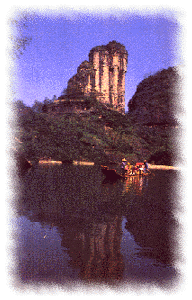 Fujian Land
Fujian Land
|
Fujian is located in the southeast region of China facing Taiwan across the Taiwan Strait. It spans an area of 121,400 square kilometres with a population of about 31,830,000. The province has a monsoonal climate in the tropical and subtropical zones and contains 9 districts and cities with 81 counties. Its ethnic groups are mostly Shezu, Huizu, and Gaoshan.
Fujian is sheltered by the Wuyi Mountain on the west and the East Sea to the east. With granite all over the province, wonderful stone landscape exists in Xiamen, Quanzhou, and Fuzhou has great influence on construction as well. Situated on the Pacific Volcano Circle, Wuyi Mountain is rich in volcanic remains and geothermal resources. Due to the good weather and abundant hot springs, Fujian contains an abundance of plants and animals with many rare species.
The history of Fujian is quite long. Frequent foreign exchanges left many navigational relics and different religions in the province. Quanzhou Navigation Museum, Luoyang Bridge, Yongquan Temple, Laozi Statue in Quanzhou, Muslim Mosque, and the Saint Followers' Tomb are very famous parts of the nation. The revolutionary historical sites here include the site of the "Gutian Meeting" and the site of the former Chishi Rebellion.
The Wuyi Mountains are also a national park of China. They lie in Chong'an County and have an area of 60 square kilometers. Cut off from the outer mountains by streams and deep valleys, sceneries can be divided into seven groups,
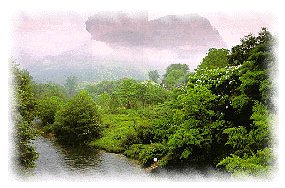 the Wuyi Mountains
the Wuyi Mountains
|
including Jiuqu (Nine Turns) Stream, Water Curtain Cave, and Wuyi Palace. The Jiuqu Stream runs nine kilometers around the mountain with nine turns and eighteen bends. One taking a bamboo raft downstream will be fascinated by its 36 different rock formations and peaks along the route, each given a name of the animal it resembles. Ascending the summit of Dawang Peak (Peak of the Great King), one can get a full view of the 36 lesser peaks that are in a posture bowing down to Dawang Peak. At the foot of Dawang Peak lies Wuyi Palace, built during the Tang Dynasty (618-907) as a place for feudal rulers to hold sacrificial service in order to honor the Lord of Wuyi. It is also a place in which the Confucians preached Confucianism. As a result of these events, a large number of cultural and historical relics have been unearthed here.
The Yongquan Temple on Gu Mountain is located in the eastern suburbs of Fuzhou. It was first built in 908 and is considered to be an important Buddhist temple. It consists of 25 halls and owns 27,900 volumes of Buddhist scriptures. With the temple situated in a central location, there are over 160 scenic and historic sites that spread out from the temple in four directions. Over 20 sites including the Lingyuan Cave and the Tingshui Hall are situated in the east. Over 50 sites including the Huilong Hall, the Luohan Terrac, and the Xianglu Peak are situated in the south. 18 caves are located in the west, and over 40 sites including the Jueding Peak and the Baiyuan Cave are in the north. In addition, there are more than 400 passages of literary works carved in the cliffs and stones of Gu Mountain. Gu Mountain is like a treasure house of calligraphy.
 Stone Carving in Fuzhou
Stone Carving in Fuzhou
|
The Fuzhou Stone Carving Factory is located on June First Road in Fuzhou. The products bear the brand name "Shoushan Stone Carving" after the name of the village from where the stone comes. The stones are noted for its fine texture and clear and transparent color. The most precious one is called the Tianhuang Stone or King Stone. More expensive than gold on the market, it is regarded as a world treasure. The making of Shoushan Stone carving has a history of more than 1,500 years. The factory's products have more than 1,000 different kinds.
The Maxwei Economic Development Zone is located in the Mawei Port where the Minjiang River and the Wulong River meet, southwest of Fuzhou. The Mawei Port is the birthplace of the Chinese navy and the cradle of China's modern industry. Now it is opened as an economic development zone. Rising over the seaside, the Luoxing Tower was first built in the Song Dynasty (960-1279) and rebuilt between 1621 to 1627 during the reign of Emperor Tianqi of the Ming Dynasty. It is a 31.5-meter-high octagonal stone structure with seven stories and an internationally recognized lighthouse. Ascending to the top of the tower, one can get a panoramic view of the docks and all the economic development area. At the foot of the tower is the Luoxing Park and next to the park is the International Seamen's Club.
 Lacquerware in Fuzhou
Lacquerware in Fuzhou
|
The Bodiless Lacquerware Factory is located on May First Street in Fuzhou. The making of Bodiless Lacquerware's products have a history of 200 years. They are noted for their light weight and durability in addition to their simple, yet graceful shape, color, luster, and pattern. The bodiless lacquerware is produced in Fujian, the cloisonne is made in Beijing, and the porcelain is made in Jingdezhen. The three combined are known as the three treasures of Chinese arts and crafts. Since 1989, it has won gold medals in several international exhibitions. Its products come in over 3, 000 varieties, such as standing screens, hanging penels, human figurines, flower vases, plates, and boxes.
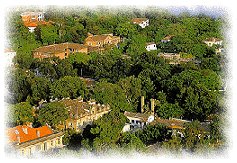 Gulangyu Island
Gulangyu Island
|
Gulangyu Island is a tiny island with an area of 1.78 square kilometers to the southwest of Xiamen across the sea. It is covered with beautiful green trees, bushes, and flowers; this is why it is also known as the "Garden on the Sea". Gulangyu Island is free of motor vehicles of any kind, and its local residents love music. More than 500 households on the island own pianos, so the island has a reputation of being an island of music. Because it has preserved many houses in different European styles of the 18th century, it is nicknamed an international exhibition of architecture. The main places of interest are Riguang Rock, Riguang Monastery, Shuzhuang Garden, Zheng Chenggong Memorial Hall, and the newly built Haoyue Park to honor Zheng Chenggong.
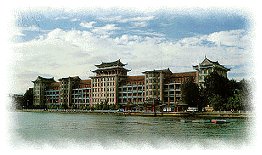 the Jimei School Village
the Jimei School Village
|
The Jimei School Village has an area of five square kilometers and was built in 1933 with funds from Mr. Tan Kah Kee, a patriot and leader of overseas Chinese affairs. After liberation in 1949, an additional 88 school buildings have been added to the village with the help of the government. The village has five universities and colleges and three secondary vocational schools with 10,000 students and teachers. There are also middle schools, primary schools, bathing beaches, gyms, facilities for sea sports, and navigation clubs. The Ao Park built in 1950 consists of a gallery at the entrance with a monument in liberation of Jimei and the tomb of Mr. Tan Kah Kee.
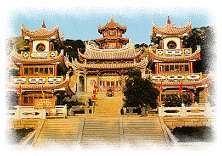 the Mazu Temple
the Mazu Temple
|
The Mazu Temple is on Meizhou Island, which is governed by Putian City, and faces Tazhong City of the Taiwan Province across the strait. It is said that Mazu was a girl originally named Lin Mo (960-987) who had saved a large number of fishermen and their vessels from seastorms in her short lifetime. After her death, a temple was erected in her honor. She is worshipped as the goddess of the sea and os also known as Tianhou or Heavenly Empress. The temple was first built in 987 during Emperor Yongxi's reign of the Song Dynasty and was expanded several occasions later. Mazu is the most popular deity along the coasts of China, as well as in all Chinese communities all over Southeast Asia. There are over 1,000 Mazu temples across the world. But the one in Meizhou is regarded as the ancestor of all the Mazu temples and is why it attracts many worshippers.
The South Putuo Temple is a famous temple located in the southern Fujian. First built during the Tang Dynasty (618-907), it covers 30,000 square meters of land with magnificent main halls and minor buildings. The temple has 28 statues of Buddha from Myanmar carved in jade and tens of thousands Buddhist scriptures both in Chinese and foreign languages. South of the temple is the Academy of Buddhism of Southern Fujian, founded in 1927. The vegetarian food served in the temple is widely known for its delicious taste. At Hulishan Fort nearby a heavy gun has remained intact after being built in 1896.
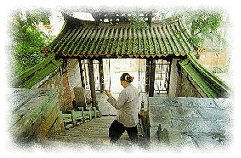 the Qingjing Mosque
the Qingjing Mosque
|
The Qingjing Mosque on Tumen Street was built around 1,000 years ago during the Song Dynasty. Being one of the oldest mosques in China, it covers a floor space of 2,100 square meters. The granite mosque is a copy of the mosque in Damascus of Syria. Its main entrance, 20 meters high and 4.5 meters wide, consists of three gates, one inside the other. All three gates are in arched form with a dome ceiling. However, the outer and the middle gates have a pointed summit at the center of their ceilings. In the middle against the west wall is the alter. The niches in the exterior of the south wall and in the wall of the altar are inscribed with passages from the Koran in Arabic.
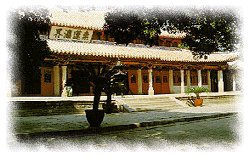 the Kaiyuan Monastery
the Kaiyuan Monastery
|
Situated on Xi Street of Quanzhou City, the Kaiyuan Monastery was first built during the second year of the reign of Emperor Chuigong of the Tang Dynasty (686). It covers more than 30,000 square meters and is one of the largest Buddhist buildings in the Fujian Province. Its main hall, Daxiongbaodian, is supported by 100 stone columns. Hence, it is nicknamed the Hundred Pillar Hall, each carved in beautiful and different designs. Carved on the cross beams are 24 flying singers and dancers resembling angels in Catholic churches. They are masterpieces of Chinese folk arts and crafts. A hall in the rear keeps five major Buddhist scriptures in 37,000 volumes. In front of the front hall are two towers over 750 years old, the tallest stone towers in China.
Qingyuan Mountain, situated to the north of Quanzhou, is a national park of China. Also called Beis Shan, Quan Mountain, or Qiyun Mountain, it has been a famous resort in southern Fujian for over 1,000 years. There are woods, streams, grotesque stones, and caves. There is also a giant stone statue of an old man that is carved out of one piece of rock 5.1 meters high, 7.2 meters thick, and 7.3 meters wide. It is believed to be the largest Taoist stone sculpture ever discovered.



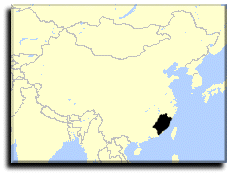
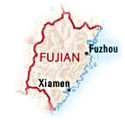












 Chinese Culture
Chinese Culture